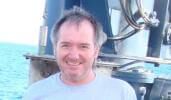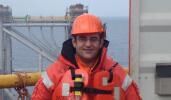6
Atlas Professional Gairn McLennan
Why this position, and why this industry?
“I have been happily working offshore because of the international travel, the big machines —if it's got a combustion engine, I’ll like it!—and the big numbers. These vessels can tow 12 or more 8 km streamers, pump 4,600 cu in of air at 2,000 psi to produce an energy pulse every 10 seconds and use 50 tonnes of diesel a day. Some vessels have five main engines and produce up to 16 thousand kilowatts of power. I’ve always thought it’s intriguing that we work about 2,500 hours a year in only seven to eight months. The best thing about being a seismic observer though, is being at sea. Here, nature rules your world.”
How would you describe your job?
“The job is always changing. I visit different geographical regions, experience all sorts of environmental conditions and climates, varying from two meters of ice to fifty degrees Celsius. I’ve witnessed a lot; from political problems with environmental activists to threats from nature, like high seas and hurricanes you have to run from. If you like challenge, what industry suits better than this one? It’s important to keep your cool and prepare for the unexpected or you’re going to struggle, especially when dealing with equipment worth 30 million US dollars. That’s always at the top of your mind. Nevertheless, worrying about your safety and the safety of your work mates is at the top of the list.
At times, this job can be very demanding. After having worked for 84 hours a week, sometimes you cannot wait to have a sleep-in. Nevertheless, there is a good variation of days in a random fashion. It can happen that you’ll be working on a 30ft boat a few hours a day or on a cable deck in a cable retrieval or deployment. Sometimes you even end up doing administration and paperwork!”
And the Seismic & Electromagnetic industry?
“I think the industry is fascinating. I’ve taken a huge interest in geopolitics, which mostly involves the oil industry and is epitomized in ‘The Prize’. What’s best about it is the state-of-the-art computing systems and the continuous improvement of technology making positioning, acquiring and processing of data more and more efficient. Before, it was an industry for people who wanted to get away from normal employment, and very few had university degrees. Nowadays, a degree is almost a must-have in order to get started.
Relatively, the industry is quite small. I would guess that the total sum of seismic marine mechanics observers, navigators, and quality controllers is maybe three to four thousand, max.”
Thinking of progressing your career?
“I think that to progress in this career you just need to keep on going. It is also important to be safety and quality orientated. Training for contractors comes from on-the-job experience and self-motivation is essential. Success can be gauged from continuous employment.”
What have the highlights been so far?
“Probably the surveys I took part in at the far north on the ice cap during the Northern summers. These trips were punctuated by polar bear sightings and port calls in Spitsbergen. The trips were spread over a period of three years in total and took place in very tough conditions. The surroundings were extremely isolated; in most cases, it took two weeks of travelling to get to civilised areas. The surveys were commissioned by the Russian Oil Ministry and the results were submitted to the International Tribunal for the Law of the Sea (ITLOS). Altogether, this assignment was just something else.”
Author: Bregje Rooijendijk
Back to overview
.png)
.png)


